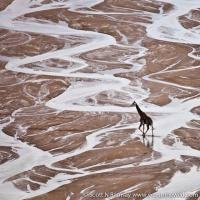World’s Most Precious Protected Places Saved in Photography Competition
On a crisp winter morning off Lady Elliot Island, a passing manta ray was snapped sweeping above the ocean floor by diver Fabrice Jaine and today that shot has been announced as the winning photograph in the international SAVED photography competition, being held to coincide with the World Parks Congress in Sydney.
The NSW National Parks and Wildlife Service’s (NPWS) Deputy Chief Executive Michael Wright said the photography competition inspired over 1200 people world-wide to share their experiences and memories of the world’s most precious places using a camera.
“I was absolutely overwhelmed with the beauty of the images submitted from all over the world in this unique competition submitted by amateurs and professionals alike,” Mr Wright said.
“Photography plays an important part in keeping the world’s most precious areas protected by raising awareness and providing historical and documentary references. But most importantly, it is also an easy way to express our appreciation for the natural world around us.
“Protected areas of the world offer a wealth of photographic opportunities for photographers of all levels and this was evident by the sheer diversity of the images submitted as part of this world-wide nature photography competition.”
Fabrice Jaine took out the major prize of $15,000 for her shot of the Manta Ray during that impromptu encounter with his dive buddy off the north coast of Australia.
Other winners included Justin Gilligan for his stunning photograph of a Blue bottle taken whilst bobbing off the coast of Eurobodalla National Park on the State’s South Coast. The Youth Category went to Kalani Gacon for a photo capturing a runner in the Blue Mountains at dawn.
The photos will now commence a State-wide tour which starts at PlanetFest which is being held this Sunday 16 November 2014 at Sydney Olympic Park.
Media Contact: Gabrielle Last 0437 695 859
Specialist Winner
Breathless Encounter by Fabrice Jaine
Protected Marine Areas such as Lady Elliot Island in the southern Great Barrier Reef not only boast high marine biodiversity but also provide ideal ‘stopovers’ for highly mobile pelagic marine species such as manta rays. On this crisp winter morning, my dive buddy Chris and I entered the waters off Lady Elliot Island to monitor this vibrant reef. We were rewarded with the most incredible underwater encounter one could ever experience - a large female manta that was so inquisitive she came to greet Chris so close he could see inside her mouth! One second she was here interacting with us, the next she had vanished with a graceful wave, leaving us only this photograph and a memory of a lifetime. Manta rays are globally classified as vulnerable to extinction die to a high demand for their gills in tradition Chinese medicine. To date, the only way to fight this phenomenon is to turn local fishing communities into caring for these animals and promote sustainable manta ray tourism.
Enthusiast Winner
Blue Bottle by Justin Gilligan
Drifting on the north-easterly sea breeze, this blue bottle was photographed in shallow water as it floated around the entrance of Mummaga Lake on the far south coast of New South Wales. The shoreline and lake floor form part of the Eurobodalla National Park, which stretches from Moruya Heads in the north to Mystery Bay in the south. Seaward of the flotsam and jetsam washed ashore at the high water mark is the Batemans Marine Park - a multiple use park that aims to protect marine biodiversity, while also supporting a wide range of recreational and commercial activities. These parks pay tribute to the area's unique biodiversity and can even evoke a moment of beauty for a typically pesky blue bottle, renowned for its summer stings on unsuspecting swimmers.
Social Winner
Giraffe on Floodplain by Scott Ramsay
"Because I love this earth. That's all I love" - Howard Roark, The Fountainhead. And I love Africa's natural landscapes and wildlife especially! Celebrating our continent's unrivaled natural heritage today. And it's people (cos we are natural too, yes!). Giraffe crossing the White Umfolozi River in Hluhluwe-iMfolozi Park in KwaZulu-Natal, South Africa
Youth Winner
‘Entranced’ by Kalani Gacon
A run through the Blue Mountains bush on a cold winter's day brings a feeling of ecstasy unlike any other. A beautiful, fragile habitat at our fingertips is something I will never take for granted. Our home, the home of the Darug and Gundungurra for millennia, has been under attack by schemes of Coal Seam Gas which we have protested against time and time again in an ongoing battle that will not die. One glance at the scenery will tell you that this is a truly sacred place, a harmoniously delicate land that cannot risk being manipulated. The beautiful local plants and animals have adapted to the most challenging conditions and have lived peacefully with the first Australians for many thousands of years before the pursuit of Greed corrupted the equilibrium. An unusually high concentration of aboriginal art found in the area is fitting with many stories of the Blue Mountains as a sacred site, a place of healing, abundant in spiritual riches as an important ceremonial site. Today we try to acknowledge it as such and will continue to listen and learn from it. The hearts of my friends and I lie within this land and we will die protecting it.










